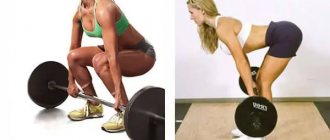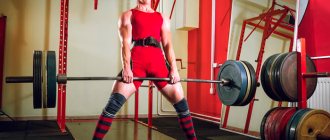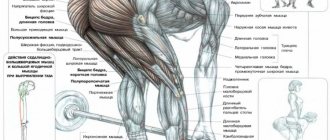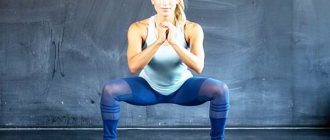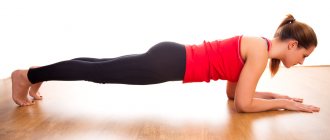Why do deadlifts
This exercise has a lot of advantages. Here are some of them:
- This is a basic exercise for any bodybuilder. It develops several large muscle groups at once (back, legs, buttocks) as well as many small ones. The work of the muscles will be described in detail below.
- Deadlifts can significantly increase your strength. The increase in strength in this exercise will be accompanied by an increase in your muscle mass.
- In some cases, with a sore back, this is an excellent opportunity to forget about pain in the spine forever.
When performing a deadlift, about 70% of the muscles of the entire body are involved in the work. This is a powerful, energy-consuming exercise that also has a functional basis. After all, this is actually lifting a heavy object from the ground. And every person faces this task more than once in his life.
Mistakes when performing deadlifts
The most common mistake is performing deadlifts while lowering the pelvis down. It is only allowed to be pulled back. The pelvis and back should form a straight line. When performing the exercise, you should not lift your feet off the floor to avoid injury.
Beginners may use too much weight to achieve quick results. This is wrong, as you can overload the body. It is better to start with a small weight, then gradually increase it.
When performed correctly, deadlifts can develop your back muscles, as well as your buttocks and thighs. It all depends on the technique of doing the exercises. Beginners should contact an instructor to avoid any problems. At first, it is not always possible to understand how to stand and lift the barbell correctly. If all the actions are explained by the master, then mistakes can be avoided.
Ask your question to the coach:
What muscles work
When performing a classic deadlift, the load on the muscles is distributed as follows:
Main working groups:
- Back muscles. The main load falls on the extensors of the spine, especially their lumbar part. Also, part of the work goes to the latissimus dorsi muscles.
- Legs and buttocks. The exercise makes the hamstrings, gluteus maximus and quadriceps muscles actively work. It’s worth saying here that the classic style of deadlifting puts less stress on the buttocks and the back of the thighs, so it is more suitable for men, but, for example, the Romanian deadlift and straight-legged deadlift are traditionally considered a more suitable option for women.
Additional load is received by:
- Forearms and hands. Holding a heavy barbell is not the easiest task for your hands.
- Trapezius muscles.
- Abdominal muscles (rectus and obliques). They stabilize your core, helping you maintain proper, safe posture.
- Calf muscles, inner thighs.
Muscle work during the exercise.
As you can see, almost the entire body is involved in this exercise.
Types of deadlifts
The classic way to perform deadlifts was mentioned above. But there are many variations of this exercise.
We list the main ones:
- Classic deadlift performed with a barbell.
- Deadlift of dumbbells on straight legs.
- Deadlift with a barbell.
- Sumo barbell row.
- Short deadlift.
In addition, variations of the barbell exercise can be performed both in Smith and with a free apparatus. The bar can be in a power rack, or simply stand on the floor.
We won't go into depth and tell you about exotic deadlift variations here, because there's no point in that. The exercises given in this article are ideal for all cases.
Deadlifting in different sports
Unlike powerlifting, the deadlift in bodybuilding is not a 100% mandatory exercise. But it allows you to develop your muscles well, making your body stronger and more respectable. Very famous athletes such as Arnold Schwarzenegger did it regularly. Among lifters, this is the basics.
Craving performed by Arnold Schwarzenegger.
- Deadlifts with a barbell are included in powerlifting triathlons.
- For the barbell push in weightlifting, the deadlift is the basic element of lifting the weight off the floor.
- For wrestlers, this is an important part of training to lift your opponent off the floor.
- This is one of the training elements in rowing.
Mainly, in all sports, this exercise is used to maximally strengthen the lower back.
Doing a classic deadlift
Before we tell you how to do a deadlift correctly, let's talk about how to hold a barbell. That is, let's talk about grip.
Grip nuances
The grip can be direct, reverse and mixed (mixed grip).
It is more correct to hold on to the bar so that your hands are turned with your palms facing your belt.
If the weight of the barbell is too heavy, athletes use a type of grip in which one hand is turned as described above, and the other with the palm facing away from you. The so-called mismatch. This really helps keep more weight off. But there are also unpleasant moments in this:
- The symmetry of the body is disrupted; over time, one side may become lower or higher than the other. The difference will be measured in mm, visually you may not notice it. However, this is a curvature of the spine.
- With such a grip (mixed), a torque occurs. The barbell seems to turn in one direction. This moment is transmitted to the spine, loading it.
- You are not training your grip strength because you are using a lighter version.
Correct deadlift technique means that your hands need to be positioned with your knuckles facing outward. If the weight does not allow you to do this, that is, your hands unclench, train your grip strength. There are special exercises for this. Choose a barbell weight that you can hold for 6-8 reps. Slowly increase the load over time.
Exercise technique
The most common option is the classic bent-leg deadlift.
Storyboard of the exercise.
It can be done either in Smith, in a power rack or from the floor. The deadlift is a foundation, so it needs to be done at the beginning of your workout. Warm up well. Stretch your lower back and legs.
- Take an empty bar (usually its weight is 20 kg), stand in front of it, placing your feet slightly narrower than your shoulders. The feet should be parallel to each other.
- Straighten your back, push your pelvis back (natural arch in the lower back). The back cannot be round. The neck is an extension of the back; there is no need to raise or lower your head.
- From this position, we tilt the body forward, moving the pelvis back. With this tilt, the shoulders should extend slightly forward beyond the line of the shins. At the same time, the knees will begin to bend (by 10-15 degrees) - this is normal.
- The tilt of the body should be 40-45 degrees.
- Lower your arms down. If you are bending over correctly, your hands should be in line with the front of your shins.
- There should be very little left to the neck. Crouch down to pick it up. At the same time, do not lean your body forward or backward. Your main task is to ensure that your shoulders move along a strictly vertical axis.
- We take the bar with the correct grip (palms facing us).
- Smoothly straighten your legs, and only then straighten your back. When you hang weights on the bar, you won't have to go as low to grab the barbell. Therefore, you just need to approach it so that the bar rests on your shin. From this position it will need to be raised.
- When you are straight, squeeze your shoulder blades together.
- Then start lowering - first your back bends to about 45 degrees (make sure your shoulders are exactly above the bar), then your legs.
Do 10-15 warm-up reps, then hang up the plates and lift weights for 6-8 reps for 3-4 sets. If the working weight is heavy, approach it gradually. You should not immediately take, for example, 150 kg.
The bar should slide along your legs all the time - first along the shin, through the knee. Next, try not to move it far from the thigh, but also do not press it there with muscle force.
The position of the body, arms and legs during movement.
There is also such a thing as a classic short deadlift. This is when the barbell stands on plates, or is located in a power frame at a certain height from the floor. This option is used to practice This is deadlift training in the upper phase, when we do not lower the weight to the floor. This option is also suitable for people with limited mobility of the hip joints. It is performed in exactly the same way as the regular classic version, the weight is simply set to a higher place. Can be done in Smith.
Notes on technique
There are a number of technical points that should be observed no matter what type of deadlift you are doing. These are the moments:
- Heels should not be lifted off the floor. Do not wear shoes with soft or springy soles. Heavy weights will push them into the floor. It is best to wear shoes with thin, uniform soles (sneakers, for example).
- Despite the fact that when describing the classic deadlift technique, we suggested placing your feet slightly narrower than your shoulders, you need to find your own version. You can place your feet shoulder-width apart, or next to each other. Find the most convenient option for yourself. This will allow you to make the technique most correct for you and your body type.
- Don't load one part of your body more than another during a deadlift. Distribute the load evenly. This is achieved through the correct position of the pelvis. If your back or legs work more, pay attention to your pelvis.
- Take care that the barbell does not roll on the floor. When you lower it during the approach, it should not slide, roll away, etc. In this regard, doing deadlifts in a frame or machine is much more convenient.
- Toes should be on the same line, no leg should protrude beyond this line. Or not reach it. Asymmetry is unacceptable!
- The technique needs to be honed on light weights.
- In Smith, it is more convenient to stand on such a side that when removing the barbell, you can rotate the bar away from you (you are standing in the machine, not in front of it). But, again, do what is most convenient for you.
- To avoid chafing your knees, use bandages. Or do deadlifts in your pants. The wounds take a long time to heal and interfere with training.
- Wear an athletic belt.
Execution in Smith
Smith makes deadlift training a lot easier.
- Firstly, the weight can be taken from different levels.
- Secondly, you can fix it at any point if it suddenly becomes difficult or painful.
- Thirdly, it goes strictly up and down, so you cannot lift it any other way, to the side.
Agree - there are a number of advantages. Perfect for people with back pain.
How to deadlift in Smith - exactly the same as outside the machine. However, do not forget that you should not do deadlifts in Smith all the time. You should try to gradually switch to free weights.
In the Smith machine.
A healthy person does not have to start mastering deadlifts with Smith.
If preparation allows, it is better to immediately take the barbell. It is better to use the simulator for those who have any problems with the spine. More on this a little further.
Deadlift - correct technique and tips for beginners
The deadlift is unloved because of its “heaviness” and complex execution technique. There is no way to “make” an exercise or perform it in a machine. However, if you want to build a muscular body, you literally have to learn how to deadlift correctly.
Is deadlifting with dumbbells acceptable?
The logic of performing a deadlift is simple - you need to lift a heavy weight from the floor while straightening up. But the point, as always, is in the details - improper load distribution overloads the joints, causes pain and creates a risk of injury.
Deadlifts with dumbbells have a number of disadvantages: firstly, the dumbbells will be lower on the floor, and it will be more difficult for you to bend over, which will create an unnecessary arch in your back; secondly, it is possible to perform a deadlift with a 100 kg barbell, while 50 kg dumbbells are unrealistic.
Deadlift technique
1. Preparation.
Standing straight, legs spaced quite narrowly (hip-width, not shoulder-width apart), feet pointing slightly to the sides. The barbell is located on the floor, its bar passes through the center of the foot (namely the entire foot, not the toe), being as close as possible to the leg itself.
Gel/air cushioned shoes (typical running shoes) are not suitable for deadlifting. Sneakers or any other shoes with flat soles are preferable, making it easier to maintain balance and avoid overloading, leading to back pain.
2. Taking the starting position.
Without bending your knees, lower your body down and place your hands on the barbell so that your knees are inside (distance about 40 cm). Your arms should be straight, with your elbows locked. Think of them like straps pulling upward.
Initially, the back will be slightly rounded, but with the next movement, bend your knees, push your chest forward, while moving your pelvis back - your back should become straight. You should feel a noticeable tension in the muscles of your lower back and back of your legs.
3. Check.
Before lifting the weight, it is important to ensure that the position is perfectly correct. Check the position of your feet and the proximity of the bar to your legs (get into the habit of checking this by checking the position of the lacing on your shoes). Don't go too low in your squat.
The shoulders should extend slightly forward beyond the line of the bar (imagine that your shoulder blades are covering the bar) - this will help to evenly load the shoulder joint. The head and neck should be in a neutral position, with the gaze directed forward.
4. Move up
. Without putting your body weight on your toes, push your chest forward and rise, keeping the barbell as close to your legs as possible. In the first phase of the movement (raising the barbell to the knees), the front surface of the thighs is involved in the work, in the second - the back surface.
In the second phase of the movement, it is especially important to engage the muscles of the buttocks and back of the thighs. Don't try to pull the weight solely with your back. At the top point, do not perform shrugs or other unnecessary movements - just lift the weight and freeze.
5. Downward movement.
Lowering the weight begins not with bending your knees, but with pushing your hips back - this will help clear the way for the barbell, preventing it from hitting your knees. Lower the barbell in this manner to the position of your kneecaps, then begin to bend your knees.
Make sure your back is in a neutral position and don't let it arch up or down. Do not put the weight of the barbell on your arms and shoulders - this will create a risk of joint injury. Also make sure that your gaze does not drop to your feet - this will upset your balance.
Deadlift mistakes
Often at the top of the movement it is recommended to tense the muscles of the back, shoulders or even arch the lower back - remember that this is a mistake. Even the English name of the exercise - deadlift - says that at the top point you should freeze (“dead stop”).
The only movement that should be performed at the top of the weight lift is to push the chest forward, but without attempting to connect the shoulder blades or tense the shoulders. Push your chest forward, pause for a second, then lower the weight down in a controlled manner. This is one repetition.
Deadlift for Beginners
In most cases, it is quite difficult for beginners to lift the barbell directly from the floor - the lighter the weight, the smaller the diameter of the plates and the lower the barbell is. Unless you're using 50-pound plates, it's best to deadlift from a stand.
The beginner must ensure that the lower back is in a neutral position. Arching your back upward is the easiest way to get injured. The remark is especially relevant for girls, who tend to arch their back not only in the lower part, but also in the upper part.
Do you need insurance and seat belts?
Straps do help you lift more than your arms can hold—however, it's important to remember that you're not in a competition. It is not the severity of the working weight that is important, but the ideal technique for performing the exercise. The use of belts is only permitted by professionals.
The same applies to the “multi-grip” technique, when one palm looks up and the other down. Such a grip makes it easier to perform the exercise, so it is only permissible in the last approaches, when you have little strength. Use a normal grip and adequate weights at first.
The deadlift is the number one exercise for working the core, lower back, abdominals, glutes and hamstrings. It is especially important for beginners to include this exercise in their training program, maintaining perfect technique.
Deadlift and sumo
Let's briefly go over the differences between these types of deadlifts and the classic ones. You can read in detail about the technique and features of each exercise in the relevant articles on our website.
Straight-legged row or deadlift
You can perform this exercise with dumbbells or a barbell. Here you will need a good stretch in the lower back and hamstrings. Take care of this in advance. Deadlifts on straight legs are better suited for girls, as they perfectly work the buttocks, back of the thigh and lower back without affecting the quadriceps.
On straight legs.
How to do deadlifts on straight legs - read a separate article on our website.
This is a lighter version of the deadlift, so you can do 10-12 repetitions in 3-4 sets.
If you take dumbbells, you need to hold them on the outside of your thigh. Their necks are parallel to your feet. And the feet are parallel to each other.
If your stretching is not enough to perform this exercise correctly, it is recommended to take a closer look at the Romanian deadlift. When performing it, the pelvis is also moved back, but the legs remain slightly bent at the knees. The bar of the bar drops to the middle of the shin.
Romanian version with slightly bent legs.
Sumo deadlift
This is a lifting type of exercise in which the legs are placed significantly wider than the shoulders and the arms are placed between them.
The wide leg deadlift is used in powerlifting.
In general, the technique is similar to the classic version, but there are a number of differences, which are also described in detail in the corresponding article.
Performing deadlifts with a barbell
Separately, it is worth considering how deadlifts are performed together with a barbell. It comes in different types. For example, there is a classic type that will help you acquire the physique of an athlete. This is the main discipline for those involved in triathlon. This exercise is also included in the training program for those people who are involved in fitness and bodybuilding.
There is a sumo technique that is included in the powerlifting program. In this case, the exercise is performed with legs widely spaced, as a result of which the amplitude of movement is reduced. As a result, the athlete will be able to lift the maximum weight.
Alexander Shestov
TRX Certified Trainer
Ask a Question
There is also a technique called "dead". It is performed with slightly bent knees. The exercise is needed to work the hips, while the load on the back is significantly reduced.
Preparation: warming up and warming up
Warm-up is the key to success, so you can’t do without it. You need to warm up the tendons in the lumbar region, then they will become more elastic. This will help avoid stretching and tearing. You will need to perform two or three approaches with minimal load. You can use, for example, an empty barbell. Then the weight is allowed to be increased and the action is repeated for two or three approaches. In this case, it is necessary to do without sudden actions in order to avoid damage and serious injuries.
Taking the starting position
It is important to focus your attention on the starting position. Feet are shoulder-width apart, toes opposite each other. When gripping, the distance between the hands should be slightly wider than the hips, and the palms should be located at the same distance from the ends of the barbell, otherwise the athlete will stagger when performing the exercise.
The athlete should be in a half-squat; you should not sit down deeply. The knees should not go beyond the barbell. The back is straight, the shoulders are straightened, the gaze is directed forward.
Lifting the barbell
The weight should be distributed evenly to the muscles of the legs and back. When lifting the barbell off the floor, its rise must be accelerated, while keeping your feet firmly planted on the floor.
Lowering the bar
As soon as the position is leveled, you need to arch your lower back and move your shoulder blades slightly back. The ankles and pelvis should be at the same vertical, with the entire load falling on the shoulders and heels.
The bar must be lowered smoothly, in about 2 seconds, observing symmetry. Sudden jerks can cause serious injury. When the pancakes touch the floor, you need to inhale two or three times. After this, you can perform the exercises again according to the same plan. The number of attempts is limited by human capabilities.
If your back hurts
Whether to do deadlifts with a sore back is a controversial issue. Most often, the correct load on the lower back strengthens it, and a person forgets about pain and begins to live a full life. There are many such examples. But this is only with the correct technique and proper selection of scales.
When unqualified trainers get down to business, everything ends badly - a hernia, serious injury, surgery. And then you can’t force a person into the gym.
It is best to consult a sports physician about back pain. Because each case is individual!
You should always focus on your own well-being. There shouldn't be any pain. If your back hurts after every workout (do not confuse muscle and joint pain), try performing partial rows (short rows), or always wear an orthopedic belt with stiffeners. If this does not help, postpone classes until you consult a specialist.
If you have a sore back, the safest option is to use a Smith machine. Work in it for the first month to strengthen the ligaments and muscles of the back.
And remember, an ordinary doctor - neurologist or traumatologist will most often prohibit you from heavy exercise. A sports doctor is a sports doctor to help you continue playing sports. Therefore, if life without a gym is unbearable for you, try looking for such a specialist in your city.
Main mistakes and difficulties
Stretching
Poor stretching is always a problem for a bodybuilder. Because of this, your deadlift technique can be severely affected. Moreover, this problem applies to any traction option.
Stretch the back of the thighs.
First you need to stretch your lower back, leg flexors, and calves. We use classic techniques for this:
- We reach the floor with our hands on straight legs. The lower you can go without rounding your back, the better. If you reach for floors with a round back, wean yourself off it. Firstly, this is harmful to the spine, and secondly, the technique of the exercise we are considering requires arching in the lower back.
- We stretch our hands to our feet while sitting on a fitness mat.
- We do stretches for the legs - splits, “reach the floor with your knees” and others.
It may take you a month to stretch enough for the lift.
Libra progress
You notice that the weight becomes light and add more. Progress seems to be going quickly. But for some reason the arch in the lower back disappears, and the back begins to round. You lift 150 kg, but in the upper phase you bring the barbell to the final point by straightening the thoracic spine. And the next day you have a strange pain in your chest. Congratulations - you have developed thoracic osteochondrosis.
More often than not, people do not feel pain and continue to gain weight. This is how serious injuries occur. What's the problem? In quickly hanging pancakes. You need to increase the weights slowly, carefully ensuring that the technique does not suffer.
If it’s easy for you, add 10 kg each workout. When it gets heavier, increase the weight by 2.5 kg. It's long, but effective. The most important thing is the right technique! When deadlifts are performed correctly, you will not get injured and you will gain strength and muscle mass.
Thrust frequency
The optimal training regimen for a bodybuilder is 1 deadlift per week. You can do 2 rows if one of them is with dumbbells, for example, on straight legs. And the second one is classic. If you work with heavy weights, it is better to leave the frequency at 1 time per week. This is because the load on the lower back is very large, both joints and ligaments are loaded. They need time to recover.
If you really want to pump up your back faster, do hyperextension 2 times a week.
Hyperextension for back training.
Step-by-step execution technique
Please note that shoes with gel or air cushioning (such as running shoes) provide excessive cushioning and are not suitable for deadlifting. Sneakers or other flat-soled shoes are preferable (in fact, they are easier to maintain balance).
Preparing for the exercise
Deadlifts are performed after pre-warming the muscles. Standing straight and confident, legs apart narrowly (hip-width apart), feet turned to the sides. The barbell is located on the floor, its bar runs through the center of the foot, being as close as possible to the leg itself. The hands on the bar are narrow and touch the knees.
Taking the starting position
Lower yourself down in a motion similar to a barbell squat and grasp the barbell so that your knees are inside your hands. The arm joints should be straight and the elbows should be fixed. A straightened back will force the back of the thighs, abdominal muscles and core to work. Push your chest forward, looking straight down.
Checking the position
Before performing a deadlift, it is important to ensure that the starting position is correct. Check the position of your feet and the proximity of the bar to your legs (get into the habit of checking the position of the lacing on your shoes). In addition, do not go too low in the squat and do not bring your knees beyond the line of your toes.
In this case, the shoulders should extend slightly forward beyond the line of the barbell (imagine that the shoulder blades are covering the barbell) - this will help to evenly load the shoulder joint and avoid overloading it. The head and neck should be in as neutral a position as possible, with the gaze directed in front of you and slightly downward.
Upward movement
Without swinging or putting your body weight on your toes, push your chest forward and rise up, keeping the bar of the barbell as close to your legs as possible. In the first phase of the deadlift movement (that is, when lifting the barbell to the knees), the front surface of the thighs is involved in the work; in the second phase (when straightening the body), the back surface is involved.
In the second phase of the deadlift movement, it is especially important to try to engage the muscles of the buttocks and back of the thighs, while pushing the pelvis forward, rather than trying to pull the weight of the barbell using the strength of the lower back and back. At the top point, do not perform shrugs or other unnecessary movements.
Moving Down
The technique for lowering the weight in the deadlift does not start with bending your knees, but by pushing your hips back - this will help clear the way for the barbell, without allowing it to hit your knees. Lower the bar in this manner until your kneecaps are in position, and only then begin to bend your knees.
The spine should be in a neutral position when moving down - do not allow the lower back to arch either up or down. In addition, do not put the weight of the barbell on your arms and shoulders - this will create a serious risk of injury to the joint. At the same time, your gaze should not drop to your feet - this will upset your balance.
